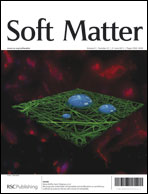Two-dimensional self-assembly of diblock copolymers into nanoscopic aggregates: from dots to disks, then rings, and finally short and long rods
Abstract
This paper presents a simple strategy that enables the two-dimensional self-assembly of an amphiphilic polystyrene-block-poly(methyl methacrylate) (PS-b-PMMA)


 Please wait while we load your content...
Please wait while we load your content...